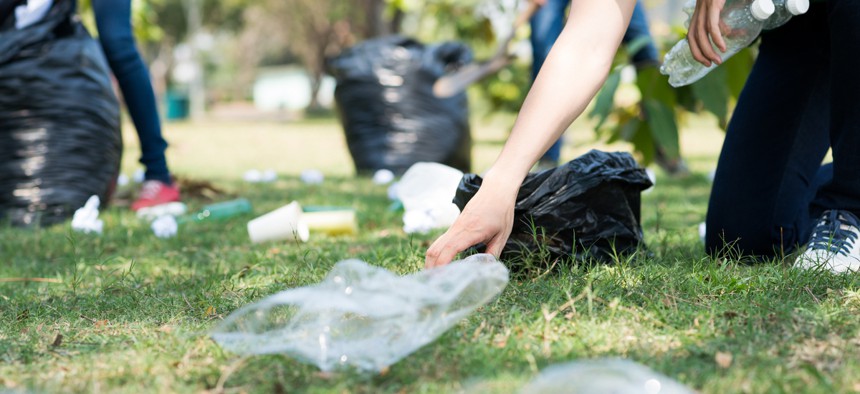Composting, Clean-Ups and Comprehensive Planning to Combat Litter

So far this year, crews in Prince George's County have picked up more than 1,000 tons of litter. Shutterstock

Connecting state and local government leaders
Prince George's County, Maryland, has struggled for years with litter. Officials have launched a multi-year, multi-pronged effort to tackle it.
Litter is a persistent problem in Prince George’s County, Maryland. Bottles, wrappers and cardboard are strewn on roadsides, while bulky furniture and old appliances sit, abandoned, in the woods. Each year, the county fields 2,500 calls about illegal dumping, and spends roughly $13 million picking up this trash.
“The state Highway Administration also has crews that pick up litter on the state roads here,” said Joe Gill, acting director of the county’s Department of the Environment. “And they’ve told me they spend more here than in any other county.”
It’s a known issue, but county officials have struggled to tackle it effectively. This month, they’re launching a multi-pronged beautification initiative that aims to change residents’ behavior with targeted messaging, long-term planning and various programs, including community clean-up events and the expansion of an existing composting project. The initiative was a priority for County Executive Angela Alsobrooks, who heard consistently from residents about litter while campaigning for her position.
“We are all keenly aware of our litter issues, and ultimately this begins to convey an image of our county that simply isn’t accurate. There is no easy way to combat the county’s trash woes, and there is no magical beautification solution that will make it go away,” she wrote in a county newsletter announcing the initiative. “The truth of the matter is it begins with all of us. The litter reflects a lack of pride in ourselves and our community. I refuse to let that be our story.”
The program officially launched May 1, but the groundwork had been laid long before, when Gill convened a meeting with a handful of outside groups—the Chesapeake Bay Trust, Trash Free Maryland, the University of Maryland's Environmental Finance Center—to begin planning a “community-based social-marketing solution” to the litter problem.
“You need to have a comprehensive, sustained campaign to change people’s behavior,” Gill said. “It’s not one or two things that need to occur—it’s all of the above. All of the various initiatives the county executive spoke about, they all fit together.”
Some of those programs are practical measures, like the installation of 33 “Bigbelly” trash compactors at litter hotspots throughout the county. The compactors are solar-powered, hold large amounts of trash and alert county staff when they need to be emptied, which county officials are hopeful will cut down on fuel consumption and pollution.
“They can go weeks without being emptied,” Gill said. “Those are a very visible sign that the county is serious about doing something about the problem.”
Another part of the plan is geared more at trying to change people's behavior at home—helping residents compost their leftover food waste. Prince George’s County launched its composting program four years ago, beginning with a volunteer pilot of 200 homes in recycling service areas. The program will expand to 3,000 homes this year, each of them receiving a 35-gallon cart and a 1.5-gallon food pail for food scraps. Those homes have a weekly garbage pickup specifically for food, which is then carted to the county’s composting facility, where it’s transformed into mulch. That program, like the beautification initiative in general, comes with a generous education component, including mailings, advertisements and town-hall meetings, Gill said.
“It gives us a chance to educate people about why it’s important, so the people who do opt in are really committed to it,” he said. “We’re converting environmentalists along the way.”
Other programs include placing hidden cameras in high-traffic illegal dumping areas (the locations are secret, as the goal is to catch dumpers in the act), new trucks and increased staff for trash pickups and a county cadet program, which pairs “litter prevention specialist interns” from high schools with summer camps, nonprofits, schools and churches to complete various projects throughout the community.
The multiple initiatives increase the chances of success, Gill said, but they also grant the county countless opportunities to tell its story.
“Since there are so many different components, we have the opportunity to feature those components over the course of the next several years,” he said. “There are so many different ways to reach people now, with different messaging that will reinforce what it is we’re trying to do.”
Eliminating litter and improving conditions in the county are the main goals, said John Erzen, a spokesman for the county executive. But the administration is also interested in a less tangible outcome.
“This all ties into a large theme in the administration of ‘Prince George’s Proud,’” he said. “One of the ways you show you’re proud of where you live is that you’re not going to be littering or doing those things, nor are you going to tolerate other people who do.”
Kate Elizabeth Queram is a Staff Correspondent for Route Fifty and is based in Washington, D.C.

NEXT STORY: Trump Hailed This State’s Prison Reforms as a National Model — but the Numbers Reflect a Grim Reality




